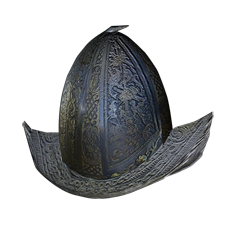Object Descriptions Tower House Study
Helmet, Spanish
When the great Spanish Armada was defeated by the English and blown away from the English Channel in 1588, many of its ships sailed homeward by first travelling north, rounding Scotland and Ireland, then travelling out into the open Atlantic on their way southwest to Spain. Many did not arrive, crashing on Irish shores in frightful weather, with thousands of sailors and soldiers lost.
Spenser was in Ireland to help administer in the aftermath of the disaster, which offered considerable spoils to the victors (see also Tower House Bedroom: Chest). This helmet, or morion, could represent a trophy and souvenir from that period or from an earlier battle, the siege of Smerwick, Co. Kerry in 1580, which involved both Spanish and Italian troops fighting under the banner of the pope. Another helmet is located in the Great Hall.
Literary Connections
The lengthy battle between Prince Arthur and the evil, tyrannical Souldan in Book V.viii of The Faerie Queene has long been read as an allegory for the English defeat of the Armada, and more recently as an allegory combining these events in Ireland, as well.

The hero of Justice, Artegall, helps mop up the Souldan’s men and drive his frightful wife, Adicia, “like an enraged cow” off into the woods (FQ V.viii.46.1). Both strength of arms and God’s grace help them to victory.
Like an ancient Roman general, Arthur takes the Souldan’s armor and shield as a trophy or “eternall token” of his victory:
Onely his shield and armour, which there lay,
Though nothing whole, but all to brusd and broken,
He vp did take, and with him brought away,
That mote remaine for an eternall token
To all, mongst whom this storie should be spoken,
How worthily, by heauens high decree,
Iustice that day of wrong her selfe had wroken,
That all men which that spectacle did see,
By like ensample mote for euer warned bee. (FQ V.viii.44)
Bibliography:
Vincent Carey, “Atrocity and History: Spenser and the Slaughter at Smerwick (1580).” Age of Atrocity: Violence and Political Conflict in Early Modern Ireland. Ed. David Edwards, Pádraig Lenihan and Clodagh Tait (Dublin: Four Courts, 2007), 79-94.
Andrew Hadfield, Edmund Spenser: A Life (Oxford: Oxford UP, 2012): 195.
Richard F. Hardin, “Adicia, Souldan.” The Spenser Encyclopedia. Ed. A. C. Hamilton (Toronto: U of Toronto P, 1990), 7-8.
Thomas Herron, Edmund Spenser’s Irish Work: Poetry, Plantation and Colonial Reformation (Aldershot: Ashgate, 2007): ch. 9.
Links
http://www.ucc.ie/celt/published/S108200/index.html (accessed 11/8/12)
[contemporary account in Spanish by Armada survivor Francisco de Cuellar, published on the CELT website of electronic texts]
http://www.sligoheritage.com/ArchSpanishArmada.htm (accessed 11/8/12)
[photographs of Armada wreck sites in Co. Sligo and (unattributed) translation of de Cuellar’s account]